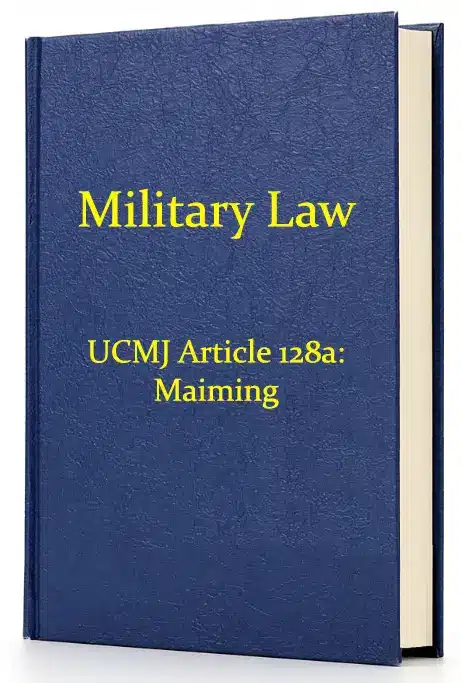The Manual for Courts-Martial states any service member may be prosecuted if they, with intent to injure, disfigure, or disable, inflicts upon the person of another an injury which:
-
seriously disfigures his person by any mutilation thereof;
-
destroys or disables any member or organ of his body or
-
seriously diminishes his physical vigor by injuring any member or organ.
To be convicted of maiming, the prosecution must demonstrate that:
-
the accused inflicted a specific injury upon a particular person;
-
this injury seriously disfigured the person’s body, destroyed or disabled an organ or member, or seriously diminished the person’s physical vigor by the injury to an organ or member; and
-
the accused inflicted this injury intending to cause some injury to a person.
Understanding Article 128a (Maiming) of the UCMJ
It is maiming to put out a person’s eye, to cut off a hand, foot, or finger, or to knock out a tooth, as these injuries destroy or disable those members or organs. It is also maiming to injure an internal organ to diminish the physical vigor of a person seriously. Likewise, it is hindering to cut off an ear or to scar a face with acid, as these injuries seriously disfigure a person. A disfigurement need not mutilate any entire member to come within the article or be of any particular type but must be such as to impair the victim’s comeliness perceptibly and materially. The disfigurement, diminishment of vigor, or destruction or disablement of any member or organ must be a severe injury of a substantially permanent nature. However, the offense is complete if such an injury is inflicted, even though there is a possibility that the victim may eventually recover the use of the member or organ or that the disfigurement may be cured by surgery.
To prove the offense, it isn’t necessary to figure out the specific means by which the injury was inflicted. However, such evidence may be considered on the question of intent. Maiming generally requires a particular purpose to injure but not a specific intent to maim. Thus, one who intends only a slight injury commits the offense if there is infliction of an injury of the type specified in this article. Infliction of the kind of injuries set in this article upon the person of another may support an inference of the intent to injure, disfigure, or disable.
Maximum Possible Punishment for Violations of Article 128a
Service members convicted of violating Article 128a face the maximum possible punishment of a dishonorable discharge, forfeiture of all pay and allowances, and 20 years’ confinement.
How do you defend against Article 128a Maiming charges?
When facing the combined military resources and the current cultural climate, you must be prepared to defend your career and freedom. Crisp and Associates, LLC has a team of experienced trial attorneys with over 75 years of combined experience who have won these cases. This team includes the firm’s founder, Jonathan Crisp, a highly respected and sought-after attorney, speaker, and lecturer who has served in the U.S. Army Judge Advocate General’s Corps (JAG) since 1998 and entered private practice in 2007.
If you, or someone you know, is facing Article 128a charges for Maiming, you need to speak with a Military defense attorney immediately. We understand what is at risk and learn how to protect your career, freedom, and future.


